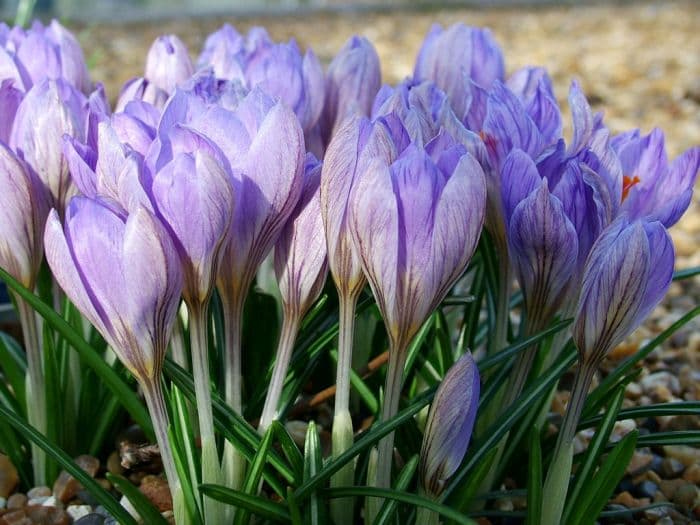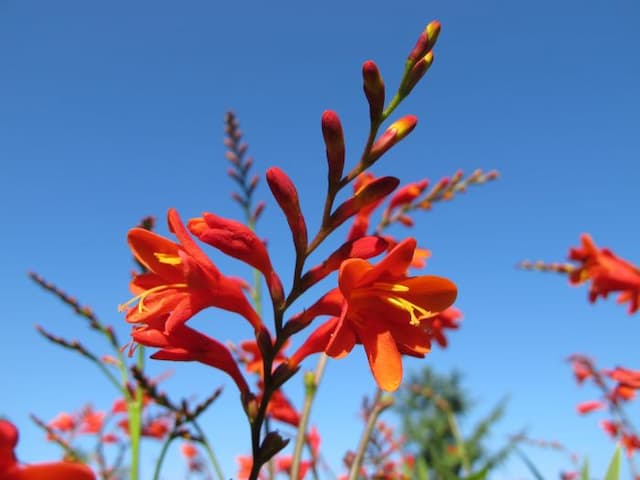Tuscan Crocus Crocus etruscus 'Zwanenburg'

ABOUT
Crocus etruscus 'Zwanenburg', more commonly known as the Tuscan crocus, is a spring-flowering bulbous plant. It is characterized by its striking flowers which have a typical crocus form: a cup-like shape with six pointed petals that can vary in color from violet to lavender, often with a silvery or white sheen that can give them a shimmering appearance in sunlight. The petals may have darker veining or stripes, which adds to their ornamental appeal. In the center of the flower, contrasting bright orange or yellow stamens are usually visible, creating a striking contrast against the lighter petals. The foliage of the Tuscan crocus is also note-worthy, consisting of slender, grass-like leaves that are often a glossy green color. These leaves may have a white or silvery median stripe that runs longitudinally down the center. As a bulbous plant, it emerges from underground storage structures, breaking through the soil in a clump or tuft-like formation. The flowers of Crocus etruscus 'Zwanenburg' typically emerge before the leaves are fully developed, with the blooms often peering out of the ground while the area may still be experiencing cool temperatures of early spring. As with most crocuses, the flowers have a fleeting beauty; they open up fully to greet the sunshine and may close at night or on cloudy days. Overall, the Tuscan crocus presents a delicate and elegant aspect, its blooms signaling the end of winter and the beginning of the warm season. Their early appearance and lovely coloration make them a favored choice for gardeners looking to add early splashes of color to their landscapes.
About this plant
 Names
NamesFamily
Iridaceae
Synonyms
Etruscan Crocus, Zwanenburg Crocus
Common names
Crocus etruscus 'Zwanenburg'.
 Toxicity
ToxicityTo humans
The plant commonly known as Spring Crocus is considered to have a low level of toxicity to humans. It is not typically dangerous, and serious poisoning is rare. However, if ingested, it may cause mild gastrointestinal upset, including nausea, vomiting, and diarrhea. In general, it is recommended to avoid eating any parts of ornamental plants due to potential adverse effects.
To pets
Spring Crocus may also have a low level of toxicity to pets. If pets ingest parts of the plant, they might experience symptoms such as vomiting, diarrhea, and gastrointestinal discomfort. Although serious poisoning is not common, pet owners should prevent their animals from eating this and other ornamental plants to avoid any possible health issues. If a pet consumes a significant amount or shows signs of distress after ingesting parts of the plant, it is important to contact a veterinarian.
 Characteristics
CharacteristicsLife cycle
Perennials
Foliage type
Deciduous
Color of leaves
Green
Flower color
Lilac
Height
4 inches [10 cm]
Spread
3 inches [8 cm]
Plant type
Bulb
Hardiness zones
5
Native area
Italy
Benefits
 General Benefits
General Benefits- Early Spring Bloom: Provides color and interest in the garden when most other plants are not in bloom.
- Attracts Pollinators: Crocus etruscus 'Zwanenburg', commonly known as Tuscan crocus, is a source of early season nectar for bees and other pollinators.
- Low Maintenance: Requires minimal care once established and is able to thrive in many types of garden soil.
- Drought Tolerant: Once established, it is tolerant to dry conditions and does not require frequent watering.
- Naturalizing: Tends to naturalize and spread over time, creating larger displays of color each spring.
- Cold Hardy: Can survive cold winter temperatures and is suitable for growing in a variety of climates.
- Deer and Rodent Resistant: Typically resistant to deer and rodent damage, which can be beneficial for gardeners dealing with wildlife issues.
- Versatile Planting: Suitable for planting in a range of locations from borders to rock gardens, pots and containers, and under trees or shrubs.
- Compact Size: Its small size makes it suitable for use in gardens with limited space or for edge planting.
 Medical Properties
Medical PropertiesThis plant is not used for medical purposes.
 Air-purifying Qualities
Air-purifying QualitiesThis plant is not specifically known for air purifying qualities.
 Other Uses
Other Uses- The corms of Crocus etruscus can be used as a natural dye source, providing colors ranging from golden yellow to brown when used with different mordants.
- These flowers can serve as a food source for pollinators like bees early in the spring when not many other plants are blooming.
- The Crocus etruscus can be planted in grassy areas to create a 'lawn carpet' effect, offering a stunning visual during its flowering season.
- It's often used in rock gardens due to its ability to thrive in well-drained soil and its preference for sunny locations.
- The flower petals of Crocus etruscus can be used in salads or as a garnish for their mild flavor and decorative appearance.
- Aphid farming is another unique use, as some gardening enthusiasts encourage the growth of aphids on crocuses to feed ladybirds in their gardens.
- The petals can be used to make natural confetti for events like weddings, providing an eco-friendly alternative to synthetic confetti.
- In crafting, dried Crocus etruscus flowers can be used in potpourri mixtures for their light, pleasant fragrance and vibrant color.
- These flowers can be used in educational settings to teach about plant biology, particularly the study of bulbous plants and their life cycle.
- Crocus etruscus can contribute to a sensory garden with its striking color and light fragrance, designed for educational purposes or to aid those with sensory impairments.
Interesting Facts
 Feng Shui
Feng ShuiThe Crocus is not used in Feng Shui practice.
 Zodiac Sign Compitability
Zodiac Sign CompitabilityThe Crocus is not used in astrology practice.
 Plant Symbolism
Plant Symbolism- Hope: Crocuses, including Crocus etruscus 'Zwanenburg' often herald the coming of spring, peeping through the snow to signal the end of winter and the hope of warmer days.
- Youthful Joy: The appearance of these flowers is associated with the joy and cheerfulness of youth, often blooming with vibrant vitality.
- New Beginnings: Their role as one of the first flowers of the year symbolizes new life and new beginnings, inspiring a sense of starting fresh or embarking on new ventures.
- Cheerfulness: The bright and varied colors of the crocus bloom bring cheer to the gloomy tail end of winter, embodying a sense of upliftment and happiness.
 Water
WaterThe Tuscan crocus requires moderate watering during its growing season. Water the plant thoroughly when the top inch of soil feels dry to the touch, which commonly equates to once a week. Depending on the environment and climate, it might need water slightly more often, particularly if it's outdoors during a particularly dry spell. Each watering should provide enough water to moisten the soil around the bulbs, which typically means about 1-2 gallons for an outdoor bed of crocuses. During their dormant period after blooming, reduce watering significantly to prevent bulb rot.
 Light
LightTuscan crocus prefers full to partial sunlight to thrive. The best spot for planting these crocuses is a location where they can receive at least 4-6 hours of direct sunlight daily. They can tolerate some light shade, especially in the afternoon, but too much shade can lead to reduced blooming.
 Temperature
TemperatureTuscan crocuses are cold-hardy and can tolerate winter temperatures down to about 15 degrees Fahrenheit, but they grow best when daytime temperatures are between 50 to 65 degrees Fahrenheit. They should be planted in an area where the extreme heat of the summer does not exceed 75 degrees Fahrenheit, as high temperatures can negatively impact their growth and flowering.
 Pruning
PruningPruning of the Tuscan crocus is minimal and primarily involves deadheading the spent flowers to maintain a tidy appearance and potentially encourage reblooming. Generally, foliage should be left to die back naturally after flowering to allow the plant to store energy for the next season. The best time for deadheading is soon after the blooms fade, but always before seed pods form if you do not wish for them to self-seed.
 Cleaning
CleaningAs needed
 Soil
SoilTuscan Crocus thrives in a well-draining, gritty mix with a slightly alkaline to neutral pH of around 6.5 to 7.5. An ideal soil recipe would be equal parts loam, sharp sand, and compost to ensure adequate nutrition and drainage.
 Repotting
RepottingTuscan Crocus bulbs should be repotted every 2 to 3 years. It is best to repot after the foliage has died back and the bulb is dormant.
 Humidity & Misting
Humidity & MistingTuscan Crocus are tolerant of a wide range of humidity levels but prefer moderate humidity. They do not require any special humidity conditions to grow well.
 Suitable locations
Suitable locationsIndoor
Place in bright, indirect light with cool temps.
Outdoor
Plant in well-drained soil with full to partial sun.
Hardiness zone
5-9 USDA
 Life cycle
Life cycleCrocus etruscus 'Zwanenburg', commonly known as Tuscan Crocus, begins its life cycle when a corm, an underground storage organ, is planted in well-drained soil and exposed to autumnal cold temperatures. The chilling period triggers the corm to break dormancy and initiate root and shoot growth. In late winter to early spring, the plant produces slender, grass-like leaves and characteristic goblet-shaped, lilac flowers with deep purple veins and bright orange stigmas. After flowering, the plant enters a period of photosynthesis and energy storage, replenishing the corm for the next cycle. As temperatures rise in late spring, the Tuscan Crocus naturally withers and enters a dormant state throughout the summer. The dormant corm survives underground during the hot months until the cycle restarts with the next cooling period in the fall.
 Propogation
PropogationPropogation time
Early autumn
The most popular method of propagation for the Crocus etruscus 'Zwanenburg', commonly known as the Tuscan crocus, is through corm division. Since these plants are cormous perennials, they naturally produce offsets or small cormlets alongside the parent corm. The best time to propagate them is in late summer after the foliage has died back or in early fall before the growing season begins. To propagate, carefully lift the clump of corms from the soil and gently separate the cormlets from the parent. Replant the cormlets at a depth of about 2 to 4 inches (5 to 10 centimeters) and space them approximately 3 inches (around 7.5 centimeters) apart to give each cormlet enough room to grow. With proper care, these cormlets will mature and develop into blooming plants in the following seasons.







![Montbretia [Little Redhead]](/_next/image?url=https%3A%2F%2Fplants-admin.emdemapps.com%2Fimages%2Fplants%2F%2Fimages%2F604b5635373f8.png&w=640&q=75)

